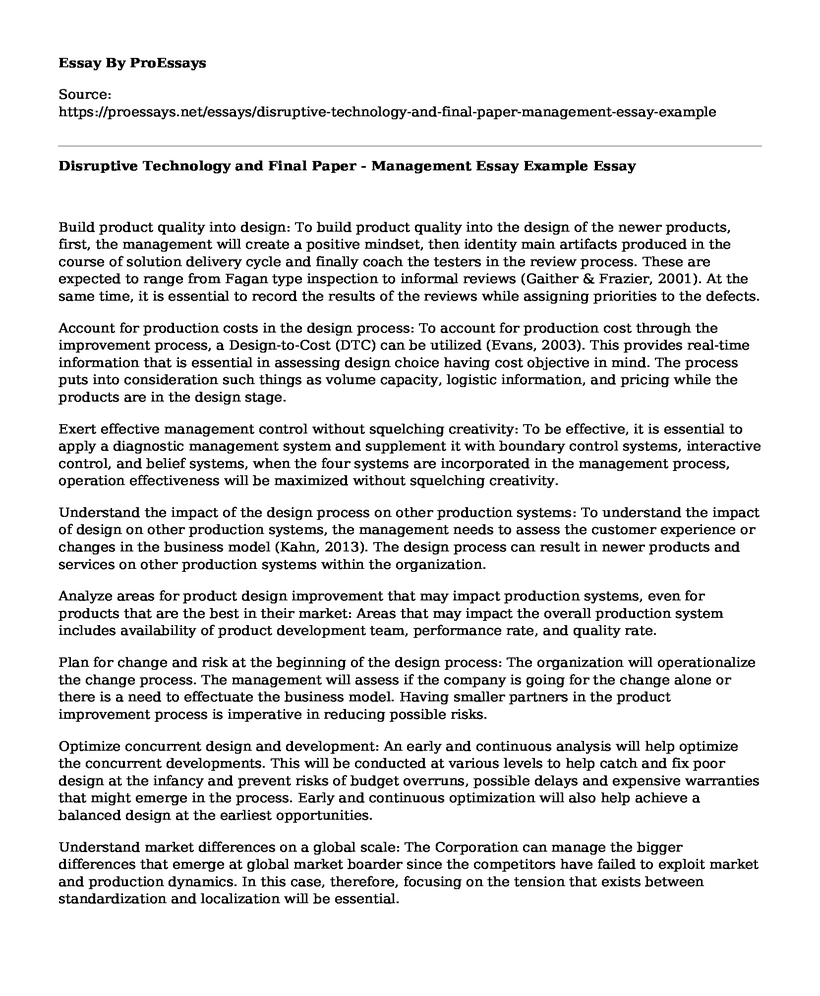Build product quality into design: To build product quality into the design of the newer products, first, the management will create a positive mindset, then identity main artifacts produced in the course of solution delivery cycle and finally coach the testers in the review process. These are expected to range from Fagan type inspection to informal reviews (Gaither & Frazier, 2001). At the same time, it is essential to record the results of the reviews while assigning priorities to the defects.
Account for production costs in the design process: To account for production cost through the improvement process, a Design-to-Cost (DTC) can be utilized (Evans, 2003). This provides real-time information that is essential in assessing design choice having cost objective in mind. The process puts into consideration such things as volume capacity, logistic information, and pricing while the products are in the design stage.
Exert effective management control without squelching creativity: To be effective, it is essential to apply a diagnostic management system and supplement it with boundary control systems, interactive control, and belief systems, when the four systems are incorporated in the management process, operation effectiveness will be maximized without squelching creativity.
Understand the impact of the design process on other production systems: To understand the impact of design on other production systems, the management needs to assess the customer experience or changes in the business model (Kahn, 2013). The design process can result in newer products and services on other production systems within the organization.
Analyze areas for product design improvement that may impact production systems, even for products that are the best in their market: Areas that may impact the overall production system includes availability of product development team, performance rate, and quality rate.
Plan for change and risk at the beginning of the design process: The organization will operationalize the change process. The management will assess if the company is going for the change alone or there is a need to effectuate the business model. Having smaller partners in the product improvement process is imperative in reducing possible risks.
Optimize concurrent design and development: An early and continuous analysis will help optimize the concurrent developments. This will be conducted at various levels to help catch and fix poor design at the infancy and prevent risks of budget overruns, possible delays and expensive warranties that might emerge in the process. Early and continuous optimization will also help achieve a balanced design at the earliest opportunities.
Understand market differences on a global scale: The Corporation can manage the bigger differences that emerge at global market boarder since the competitors have failed to exploit market and production dynamics. In this case, therefore, focusing on the tension that exists between standardization and localization will be essential.
References
Evans, N. (2003). Business innovation and disruptive technology (1st ed.). Upper Saddle River: Prentice-Hall.
Gaither, N., & Frazier, G. (2001). Production and operations management. Cincinnati, Ohio: South-Western College Pub.
Kahn, K. (Ed.). (2013). the PDMA handbook for new product development. 3rd edition. Hoboken, N.J.: Wiley & Sons
Cite this page
Disruptive Technology and Final Paper - Management Essay Example. (2021, Jun 23). Retrieved from https://proessays.net/essays/disruptive-technology-and-final-paper-management-essay-example
If you are the original author of this essay and no longer wish to have it published on the ProEssays website, please click below to request its removal:
- Fred Hampton: I Am a Revolutionary
- ERP and SCM Software Essay
- Privacy Risk With Social Media Essay
- Paper Example on The Impact of Computer Workstations on Performance
- Essay on Operations Management: Resource Management to Deliver Goods & Services
- Paper Example on Global Strategies for Medifast Ado: Key Considerations
- Evaluating the External Environment - Free Essay Example







